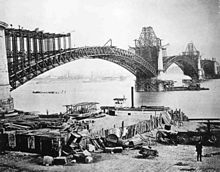James Buchanan Eads
James Buchanan Eads ( May 23, 1820 - March 8, 1887 ) was an American engineer and inventor .
Eads was born in Lawrenceburg , Indiana , and named after his mother's cousin, then MP and later President of the United States, James Buchanan . He spent his childhood in St. Louis , Missouri .
After developing a diving bell at the age of 22, he made his initial fortune rescuing items from rivers, particularly after ship accidents on the Mississippi River . He also constructed special salvage ships for lifting sunken ships in the river bed.
After the outbreak of the American Civil War in 1861, he was from the United States Navy contractually obligated ironclads to construct (Ironclads). He managed to produce eight such ships in just 100 days. He continued this activity until the end of the war. He is known for outstanding engineering achievements, such as the Eads Bridge over the Mississippi, named after him .
Eads died on March 8, 1887 in Nassau ( Bahamas ).
bridge
After the war, Eads constructed a combined road and railroad bridge over the Mississippi from 1867 to 1874, which at the time of its opening on July 4, 1874 was the longest bridge in the world with a total length of 1,964 meters. The Eads Bridge between St. Louis and East St. Louis was the first bridge to be built using the cantilever method. It was also the first bridge building project to use caissons and real steel .
After it was destroyed by a tornado in 1871, it was rebuilt under the condition that it could withstand a tornado, and indeed it survived the St. Louis-East St. Louis tornado in 1896. As a railway bridge, it was built in 1869 by the MacArthur Bridge replaced.
Further engineering services
The silting up of the fairway on the Mississippi, especially between New Orleans and the Gulf of Mexico, often resulted in ships running aground or the river not being navigable for a while. Eads solved the problem with a system of wooden structures, with the help of which the main drain was narrowed so much that the current accelerated and the fairway became deeper again. The river became navigable all year round, but floods such as those in 1927 and Hurricane Katrina in 2005 were made worse.
Eads also designed a gigantic railway system with which ocean-going ships would be transported across the isthmus of Tehuantepec from the Gulf of Mexico to the Pacific . However, this facility was never built.
Awards
In 1872 Eads was elected to the National Academy of Sciences .
In 1884 he was the first US citizen to be awarded the Albert Medal of the Royal Society of the Arts .
The town of Port Eads on the southern tip of Louisiana was named after him.
The city of St. Louis awarded him a star on the St. Louis Walk of Fame .
Web links
- James Buchanan Eads. In: Structurae
- Background information (English)
| personal data | |
|---|---|
| SURNAME | Eads, James Buchanan |
| BRIEF DESCRIPTION | American engineer and inventor |
| DATE OF BIRTH | May 23, 1820 |
| DATE OF DEATH | March 8, 1887 |

